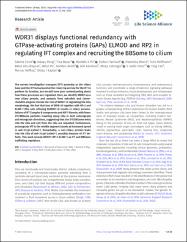WDR31 displays functional redundancy with GTPase-activating proteins (GAPs) ELMOD and RP2 in regulating IFT complex and recruiting the BBSome to cilium

Göster/
Erişim
info:eu-repo/semantics/openAccessTarih
2023Yazar
Cevik, SebihaPeng, Xiaoyu
Beyer, Tina
Pir, Mustafa Samet
Yenisert, Ferhan
Woerz, Franziska
Hoffmann, Felix
Altunkaynak, Betul
Pir, Betul
Boldt, Karsten
Karaman, Asli
Cakiroglu, Miray
Oner, S. Sadik
Cao, Ying
Ueffing, Marius
Kaplan, Oktay İsmail
Üst veri
Tüm öğe kaydını gösterÖzet
The correct intraflagellar transport (IFT) assembly at the ciliary base and the IFT turnaround at the ciliary tip are key for the IFT to perform its function, but we still have poor understanding about how these processes are regulated. Here, we identify WDR31 as a new ciliary protein, and analysis from zebrafish and Caeno-rhabditis elegans reveals the role of WDR31 in regulating the cilia morphology. We find that loss of WDR-31 together with RP-2 and ELMD-1 (the sole ortholog ELMOD1-3) results in ciliary accumu-lations of IFT Complex B components and KIF17 kinesin, with fewer IFT/BBSome particles traveling along cilia in both anterograde and retrograde directions, suggesting that the IFT/BBSome entry into the cilia and exit from the cilia are impacted. Furthermore, anterograde IFT in the middle segment travels at increased speed in wdr-31;rpi-2;elmd-1. Remarkably, a non-ciliary protein leaks into the cilia of wdr-31;rpi-2;elmd-1, possibly because of IFT de-fects. This work reveals WDR31-RP-2-ELMD-1 as IFT and BBSome trafficking regulators.

















